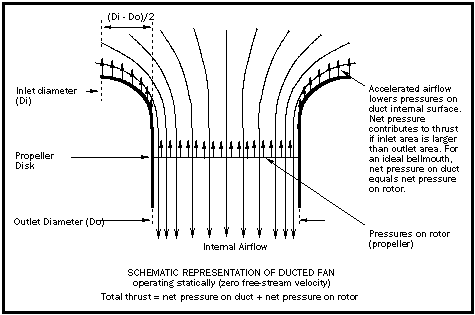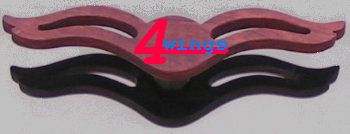Duct Myths
Widespread
disagreement prevails about the properties of ducted
fans—or shrouded propellers as they are sometimes called. In general,
the term ducted fan is applied to configurations of small disk
area, high rpm, and low aspect ratio (long, narrow ducts), while a shrouded
propeller has larger diameter, lower disk loading, lower rpm, and a
high aspect ratio (short chord) duct. Many varieties of ducts and
shrouds are possible, each with its own characteristics, which explains
the conflicting opinions and evidence regarding their efficacy. One
duct design serves all applications is the biggest misconception.
First, let us dispel a couple
of myths:
Myth 1: A ducted fan is less
efficient than a free propeller.
This is a meaningless statement, since it does nothing
to compare apples with apples. Whether ducted or free, the basic rule
is that a propeller with low disk loading (thrust or power vs. disk
area) will be more efficient than one with high disk loading. Small
diameter, high disk loading ducted fans are often conceived to allow
the use of a high rpm engine running a direct drive propeller. While
these highly loaded fans (if properly designed) will be more efficient
than a free propeller of the same diameter, they typically won't match
the efficiency of a larger free propeller (of much lower disk loading),
leading to the myth that ducted fans are “less efficient.” This
design approach can be seen in drone's ( UAV's) where the majority is
powered by small ( reasonable priced ) engines and propeller while the
minority uses big propeller with higher torque engines ( Higher priced
components ) and only a few use high rpm ducted fans.
It has been amply demonstrated, both theoretically and
empirically, that a ducted fan (shrouded propeller) system, properly
designed for a specific operating condition, will always outperform
(propulsive) a free propeller of the same diameter (that is, it will
produce more thrust for the same power input) at that operating
condition. While this fact is always true (at least at subsonic
speeds), it neglects the drag of the duct itself, which at high speeds
can easily overcome propulsive benefits.
Myth 2: Ducted fans are efficient
only at high speeds (where turbofans operate efficiently).
In fact the opposite is true. As speeds increase, high
mass flow becomes easier to attain as a result of the speed itself,
making large disk-areas (and ducts) less important or effective. At the
same time, however, duct drag rises with the square of the speed.
Why then do turbofan engines always place the compressor
in a duct? For a very different reason: to slow the airflow so that the
compressor can operate supersonically even when the aircraft is close
to sonic speeds—or even supersonic! The compressor duct of a turbofan
engine actually lowers the propulsive efficiency of the compressor
(slows the airstream) in order to avoid a transonic drag rise.
The UDF (unducted fan) seeks to avoid this tradeoff by
doing away with the duct altogether and designing the compressor
(propeller) with exotic plan forms and airfoils to operate efficiently
in the transonic realm. This approach has its own problems, of course,
and the ducted, high bypass turbofan is still the most efficient
high-speed engine we have. Just this does not apply to us Hovercraft
builder.
Myth 3: The duct is dead weight
and just increases drag of craft
Just opposite can be the case if
the duct is a fix component of your craft and provides strength to the
hull as well as skin of the craft. And this is actually not a new approach as seen in the following clip out of our grandfathers time frame : Stipa-Caproni Flying Barrel (take-off footage only)
Which evolved over the next 8 years into : Italian 1940 Caproni Campini N.1 jet plane
If you compare the two clips you can see that the duct shape changed
drastically ...but lets get out of the past and join the current where
the following ESTOL concept makes quite some sense for a small size
Hovercraft where the duct is integrated into the craft structure
In a first aspect everybody sees
the duct as a attached unit to the aft end of the Hovercraft craft -
the engine located in front of it and the duct producing high drag at
the low craft speed.
If you try to rethink this aspect
you will get to a design as the Donar
where the duct is a part of the craft and ad's not only a high amount
of safety in aspect of blade failure but as well aerodynamic streamline
appearance and strength to the craft. Or as we use in the Alpha-II
the duct is integrated in the lower hull of the craft, provides the
positive aspect of a self draining cockpit, reduced noise because of
it's high length of more than 6' to the internal skin of the craft. A
perfect location to integrate the control surfaces to make this
craft better maneuverable without aft reverse thrust buckets - and a
aerodynamic efficient thrust force.
If
you take the same design approach to Drone's ( UAV's
) than the additional weight of the duct will be compensated by less
carbon fiber components for your electronics as flight controller
and ESC's or
as seen in the following clip a compact and robust Drone
Duct Physics Without Numbers
We begin by looking at a ducted
fan operating statically (zero free-stream velocity or airspeed).
 According to this simplified
approach, for a ducted fan system operating statically, net pressures
on the duct inner surface will contribute to thrust if the inlet area
is larger than the outlet area (called positive camber). In reality, it
has been shown that even a zero-camber duct can contribute to thrust,
due to the complex 3 dimensional flow around and through the duct.
According to this simplified
approach, for a ducted fan system operating statically, net pressures
on the duct inner surface will contribute to thrust if the inlet area
is larger than the outlet area (called positive camber). In reality, it
has been shown that even a zero-camber duct can contribute to thrust,
due to the complex 3 dimensional flow around and through the duct.
For a given propeller there is an
ideal duct shape (bell mouth) which will optimize the duct’s
contribution to static thrust. The magnitude of this contribution from
the duct can be significant; a theoretical result (from Theodorsen’s
Theory of Propellers) states that the thrust of a ducted fan with an
ideal bell mouth will be equally divided between pressures on the rotor
and pressures on the duct!
A further important factor
is "diffuser ratio", being the ratio of exit_area/disk_area.
Theoretically, static thrust increases with diffuser ratio: as the
induced airflow is slowed by the expanding duct aft of the propeller
disk, pressures increase on the inner duct wall, thus
contributing to thrust. In practice, diffuser ratio is strictly limited
by the requirement to avoid separation. In summary, ducted fans
can produce more thrust than a free propeller of the same diameter for
the following reasons:
- The duct extends the reach of
the propulsion system radially to work on a larger mass of air (by
analogy, “non-planar” propulsion system) and thus the system
takes on the characteristics of a free propeller of larger
diameter.
- If clearances between the
propeller tips and duct wall are kept small compared to tip chord, the
presence of the duct wall will maintain pressures on the blade towards
the tip, improving blade L/D.
Since the total thrust of a
ducted fan/shrouded propeller is the sum of pressures on the propeller
and pressures on the duct, to increase thrust one increases the
net propulsive pressures on the duct and/or on the propeller. To
increase net pressures on the propeller for a given power input, one
increases the blade L/D by keeping tip clearances small. To increase
net pressure on the duct, one optimizes the duct geometry for a
specific airspeed.
Cool link - a must read if this topic
interest you : http://www89.pair.com/techinfo/MassFlow/massflow.htm
Marks page on Ducted Fan and Shrouded Propeller - get his book - it's
worth every penny.
Hope you enjoy the script
Michael 4wings.com
update -01- 2015
|

